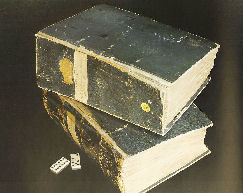Louis Braille was born on January 4, 1809 in Coupvray, France. At the age of three, his eye was injured by a sharp tool while playing in his father's shop. An infection set in and spread to his other eye, causing Louis to become completely blind.
When he was ten, Louis was sent to the Royal Institute for Blind Youth in Paris, where he lived and studied. He was a diligent student who excelled at his studies and exhibited a considerable talent for music. He went on to develop the system that is today known as the braille code, which employs a six-dot cell of raised characters that is read with the fingertips.
Louis Braille died on January 6th, 1852, at the age of 43, from tuberculosis. It was several years before his development of the braille code and his contributions to literacy for blind individuals everywhere were recognized and acknowledged. His body was moved to the Pantheon in Paris on the centenary of his death in 1952, joining other French notables such as Pierre and Marie Curie.

Braille has been adapted into many languages, and is used everywhere for signage, for music notation, and in trade and text books.
Braille takes up much more space than regular print. For example, the braille version of Harry Potter and the Deathly Hallows is eight volumes and weighs about 12 pounds. A standard elementary or middle school math book may be 10 to 15 volumes in Braille. Science text books can be even larger.
Braille is an extremely important tool in the education of blind and partially sighted children, because it is the key to literacy, success, and future employment. Audio books are also a useful component, but do not substitute for learning to read, spell, and use proper punctuation. Some organizations like the National Federation of the Blind![]() and the American Foundation for the Blind
and the American Foundation for the Blind![]() cite only a 10 to 20 percent literacy rate among blind students, and have launched recent campaigns to promote braille literacy in schools and communities. (Louis Braille: A Touch of Genius. C. Michael Mellor. Boston, Mass.: National Braille Press, 2006.)
cite only a 10 to 20 percent literacy rate among blind students, and have launched recent campaigns to promote braille literacy in schools and communities. (Louis Braille: A Touch of Genius. C. Michael Mellor. Boston, Mass.: National Braille Press, 2006.)
The New York State Talking Book & Braille Library has an outstanding collection of standard and print braille books (a standard children's book with braille pages inserted) that are available for loan to eligible borrowers. The collection comprises over 18,000 unique braille titles of fiction and non-fiction, with reading levels from pre-K through adult. These titles may also be borrowed by registered libraries or schools that would like to promote braille literacy and awareness to their own library patrons or local communities. If you would like more information about borrowing a display collection, please contact Michael Whitney at (800) 342-3688 or e-mail Michael.Whitney@nysed.gov.
 This diagram shows the dots used to make the braille version of the letters A through J.
This diagram shows the dots used to make the braille version of the letters A through J.
(Images on this page are from Louis Braille: A Touch of Genius. C. Michael Mellor. Boston, Mass.: National Braille Press, 2006.)
Information originally published in 2009, in commemoration of the 200th anniversary of Louis Braille's birth.